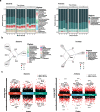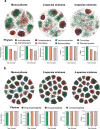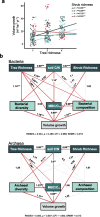Tree and shrub richness modifies subtropical tree productivity by regulating the diversity and community composition of soil bacteria and archaea
- PMID: 37996939
- PMCID: PMC10666335
- DOI: 10.1186/s40168-023-01676-x
Tree and shrub richness modifies subtropical tree productivity by regulating the diversity and community composition of soil bacteria and archaea
Abstract
Background: Declines in plant biodiversity often have negative consequences for plant community productivity, and it becomes increasingly acknowledged that this may be driven by shifts in soil microbial communities. So far, the role of fungal communities in driving tree diversity-productivity relationships has been well assessed in forests. However, the role of bacteria and archaea, which are also highly abundant in forest soils and perform pivotal ecosystem functions, has been less investigated in this context. Here, we investigated how tree and shrub richness affects stand-level tree productivity by regulating bacterial and archaeal community diversity and composition. We used a landscape-scale, subtropical tree biodiversity experiment (BEF-China) where tree (1, 2, or 4 species) and shrub richness (0, 2, 4, 8 species) were modified.
Results: Our findings indicated a noteworthy decline in soil bacterial α-diversity as tree species richness increased from monoculture to 2- and 4- tree species mixtures, but a significant increase in archaeal α-diversity. Additionally, we observed that the impact of shrub species richness on microbial α-diversity was largely dependent on the level of tree species richness. The increase in tree species richness greatly reduced the variability in bacterial community composition and the complexity of co-occurrence network, but this effect was marginal for archaea. Both tree and shrub species richness increased the stand-level tree productivity by regulating the diversity and composition of bacterial community and archaeal diversity, with the effects being mediated via increases in soil C:N ratios.
Conclusions: Our findings provide insight into the importance of bacterial and archaeal communities in driving the relationship between plant diversity and productivity in subtropical forests and highlight the necessity for a better understanding of prokaryotic communities in forest soils. Video Abstract.
Keywords: Archaea; BEF-China; Bacteria; Shrub competition; Tree growth; Tree species richness.
© 2023. The Author(s).
Conflict of interest statement
The authors declare no competing interests.
Figures






Similar articles
-
Plants Play Stronger Effects on Soil Fungal than Bacterial Communities and Co-Occurrence Network Structures in a Subtropical Tree Diversity Experiment.Microbiol Spectr. 2022 Jun 29;10(3):e0013422. doi: 10.1128/spectrum.00134-22. Epub 2022 Apr 27. Microbiol Spectr. 2022. PMID: 35475656 Free PMC article.
-
Tree species and genetic diversity increase productivity via functional diversity and trophic feedbacks.Elife. 2022 Nov 29;11:e78703. doi: 10.7554/eLife.78703. Elife. 2022. PMID: 36444645 Free PMC article.
-
Plant diversity and soil properties regulate the microbial community of monsoon evergreen broad-leaved forest under different intensities of woodland use.Sci Total Environ. 2022 May 15;821:153565. doi: 10.1016/j.scitotenv.2022.153565. Epub 2022 Jan 29. Sci Total Environ. 2022. PMID: 35101489
-
Toward harnessing biodiversity-ecosystem function relationships in fungi.Trends Ecol Evol. 2025 Feb;40(2):180-190. doi: 10.1016/j.tree.2024.10.004. Epub 2024 Nov 11. Trends Ecol Evol. 2025. PMID: 39532622 Review.
-
Community context for mechanisms of disease dilution: insights from linking epidemiology and plant-soil feedback theory.Ann N Y Acad Sci. 2020 Jun;1469(1):65-85. doi: 10.1111/nyas.14325. Epub 2020 Mar 13. Ann N Y Acad Sci. 2020. PMID: 32170775 Free PMC article. Review.
Cited by
-
Ecological mechanisms of microbial assembly in clonal plant Glechoma longituba: from soil to endosphere.Appl Environ Microbiol. 2025 Jun 18;91(6):e0033625. doi: 10.1128/aem.00336-25. Epub 2025 May 12. Appl Environ Microbiol. 2025. PMID: 40353652 Free PMC article.
-
Multitrophic Diversity of the Biotic Community Drives Ecosystem Multifunctionality in Alpine Grasslands.Ecol Evol. 2024 Nov 5;14(11):e70511. doi: 10.1002/ece3.70511. eCollection 2024 Nov. Ecol Evol. 2024. PMID: 39507800 Free PMC article.
-
Microbes, macrophages, and melanin: a unifying theory of disease as exemplified by cancer.Front Immunol. 2025 Feb 6;15:1493978. doi: 10.3389/fimmu.2024.1493978. eCollection 2024. Front Immunol. 2025. PMID: 39981299 Free PMC article. Review.
References
Publication types
MeSH terms
Substances
LinkOut - more resources
Full Text Sources

